Basketball Offense - 5-Out (Open Post) Flex Offense
By Dr. James Gels, from the Coach’s Clipboard Basketball Playbook, @ www.coachesclipboard.net
This offense represents a combining of the Flex offense, and the 5-out (open post) set, and could be used against man-to-man defenses. To understand the basic patterns of the Flex and the 5-Out offense, see Flex Offense and 5-Out Open Post Offense.
If you like running a 5-out offense, this flex pattern gives your 5-out offense a whole new look, and is something you could call from the bench, or in a time-out. Additionally, you could extend this offense out higher and use it as a delay offense.
5-Out Set and the Basic Flex Pattern
Starting with diagram A, we are in a 5-out "open post" set with no post players and five perimeter players. Our point guard O1 starts the pattern, and could actually start it either to the right or the left... here we show it starting right. O1 passes to O2, makes a basket cut, and then screens for O5. O5 makes the "flex cut" either over or under the screen for a possible pass inside from O2. O3 replaces O1 at the top.If the pass to O5 is not there, O2 passes back to O3 at the top (diagram B). After this pass, O5 back-screens for O2 and fills O2's spot at the right wing, while O2 back-cuts around the screen for a possible pass from O3. Or, O3 passes to O1 (filling the left wing spot), and O1 could pass inside to O2. After passing to O1, O3 basket-cuts and then screens for O4 (diagram C). O4 makes the flex cut, looking for the pass from O1. O5 fills the top spot and O2 moves to the corner.
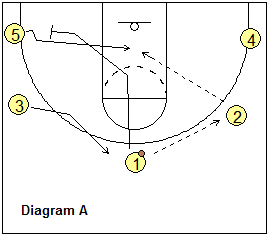
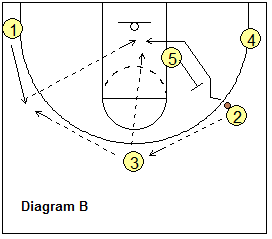
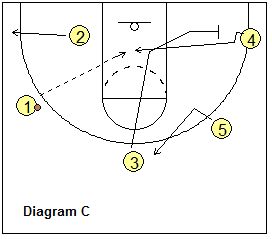
If the pass to O4 is not there, O1 passes back to O5 at the top (diagram D). After this pass, O4 back-screens for O1 and fills O1's spot at the left wing, while O1 cuts around the screen for a possible pass from O5. Or, O5 passes to O3 (filling the right wing spot), and O3 could pass inside to O1. After passing to O3 (diagram E), O5 basket-cuts and then screens for O2. O2 makes the flex cut, looking for the pass from O3. O4 fills the top spot and O1 moves to the corner. If the pass to O2 is not there, O3 passes back to the O4 at the point (diagram F). Then O2 back-screens for O3 and fills the right wing, while O3 cuts around the screen to the hoop.
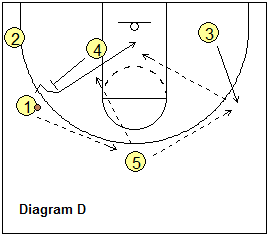
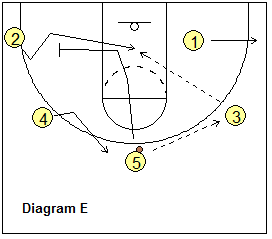
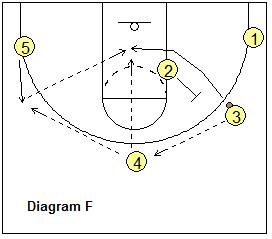
If the pass to O3 is not there, O4 passes to O5 (diagram G) at the left wing. After passing to O5, O4 basket-cuts and then screens for O1. O1 makes the flex cut, looking for the pass from O5. O2 fills the top spot and O3 moves to the corner. So you can see how this basic pattern has continuity and keeps repeating itselt, with all players rotating through all of the five perimeter positions.
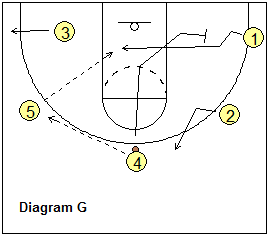
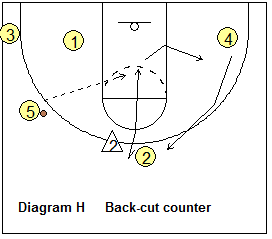
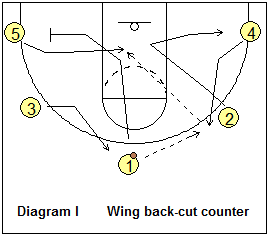
Counters... when the defense denies the pass on the perimeter
In diagram H, the X2 defender is denying the pass from O5 to O2 at the point. O2 must recognize this defensive overplay, and then back-cut to the hoop. Here O5 might get the quick pass inside to O2 for the lay-up. The weakside corner O4 must also recognize this and replace O2 at the top.In diagram I, the pass is being denied from O1 to O2 on the wing. O2 reads this defensive overplay and back-cuts to the hoop for the possible pass, and will fill the same side corner, as the corner O4 rotates up to the wing to take the pass from O1. Once this pass is made, we are back in the familiar pattern... O1 basket-cuts, screens for O5, and O5 flex cuts, etc.
You can also design your own counters and plays... adapting some of the counters and plays used with the standard Flex Offense.